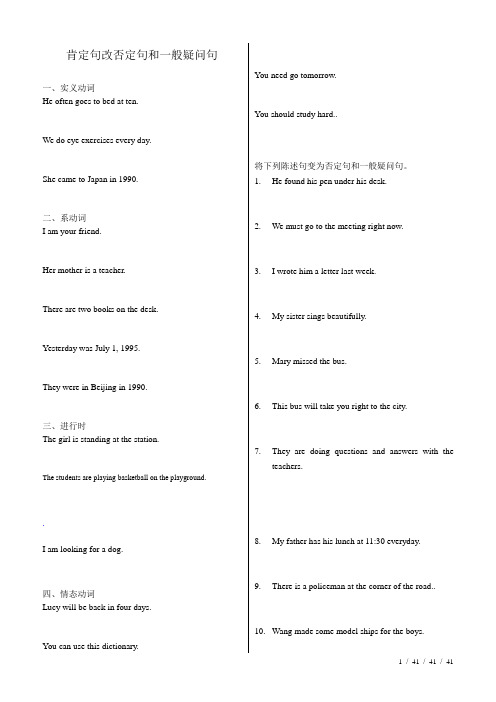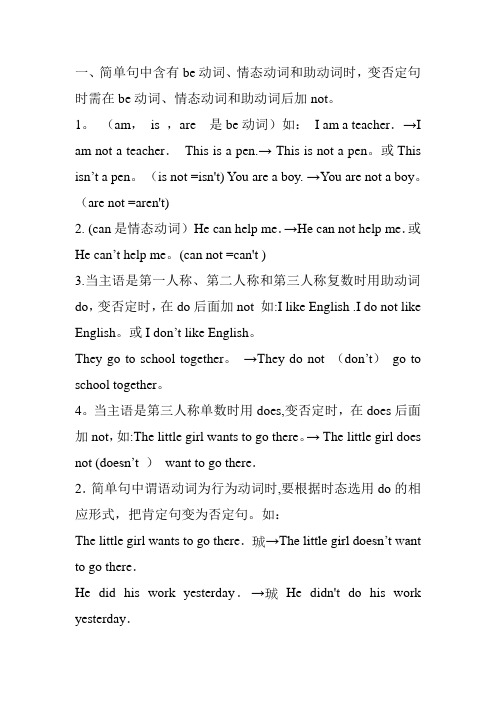小学英语-肯定句变否定句
- 格式:doc
- 大小:18.00 KB
- 文档页数:2

一、首先,要看肯定句中是否有情态动词,如果有情态动词,直接在情态动词后面加not即可,同时句中如果有some,some就要变成any。
举例如下:1、肯定句:Mike can help you solve the problem.译文:迈克可以帮你解决那个问题。
否定句:Mike can't help you solve the problem. (can't=can not)译文:迈克不能帮你解决那个问题。
2、肯定句:You should lend some money to Mary.译文:你应该借给玛丽一些钱。
否定句:You shouldn't lend any money to Mary. (shouldn't=should not)译文:你不应该借钱给玛丽。
二、如果肯定句中没有情态动词,那就要看句中有无be动词的相应形式,如果有,直接在be动词后面加not,句中有some,some变any。
举例如下:1、肯定句:I am an English teacher.译文:我是一名英语老师。
否定句:I‘m not an English teacher.译文:我不是一名英语老师。
2、肯定句:There are some books on the desk.译文:书桌上有一些书。
否定句:There aren't any books on the desk.译文:书桌上没有书。
三、如果肯定句中既没有情态动词,也没有be动词,那么就要用相应的助动词加上not来变换,句中有some,some变any。
举例如下:1、肯定句:She likes helping others.译文:她喜欢帮助别人。
否定句:She doesn't like helping others.译文:她不喜欢帮助别人。
2、肯定句:They have some apples.译文:他们有一些苹果。

肯定句变否定句的口诀如下:
改前面,加not;
含实义的词,直接变否定;
变be动词、助动词,not后面;
变have 与 do ,在前面加don't 。
如前所述,根据这个口诀,我们可以通过以下步骤将肯定句转变为否定句:
1. 若句子中没有情态动词,可直接在句子前加not,例如:He is a doctor.(他是一名医生。
)-> He is not a doctor.(他不是一名医生。
)
2. 若句子含有情态动词,直接将情态动词后面的动词原形变为动词的否定形式,例如:She can swim.(她会游泳。
)-> She cannot swim.(她不会游泳。
)
3. 当句子中含有be动词时,将be动词后面的动词原形变为动词的否定形式,并在be动词前加not,例如:They are happy.(他们很开心。
)-> They are not happy.(他们不开心。
)
4. 当句子中含有have或do时,将have或do变为其否定形式(has变为hasn't,do变为don't),例如:I have a pen.(我有一支钢笔。
)-> I don't have a pen.(我没有一支钢笔。
)
需要注意的是,对于助动词have和do,它们的否定形式是通过在前面加上don't来表示否定,而对于be动词来说,它的否定形式是通过在be动词后面加not来表示否定。

小学英语句型转换方法+口诀大全1、肯定句改否定句的方法:1.在be动词后加not如:is not, are not,am not2.在can,should,will等后加not如:cannot, should not,will not;3.上述都没有的,在动词前加助动词否定形式don't/doesn't/didn't4、some 改成any如:I am a girl. →I am not a girl.You are a student. →You are not a student.→You aren’t a student.This is Tom’s bag, →This is not Tom’s bag.→This isn’t Tom’s bag.2、肯定句改一般疑问句的方法1.把be动词放在句首,剩下的照抄(some 改成any,I改成you,my改成your)句点改成问号。
2.把can,shall,will等放到句首,剩下的照抄(some 改成any,I改成you,my改成your)句点改成问号。
3.上述都没有的,在句首请助动词Do/Does/Did帮忙,剩下的照抄,(some 改成any,I改成you,my改成your,)句点改成问号注意:句首的第一个字母要大写,句尾标点应为“?”如:I am in Class 6. →Are you in Class 6?You are from America.→Are you from America?It is an orange. →Is it an orange?4、就一般疑问句回答一般疑问句有两种回答,即:肯定回答和否定回答。
其中,肯定回答用yes,否定回答用no。
语句顺序为:Yes + 主语+ am /is/ are/was/were.|can.|do/does/did|;No + 主语+ am not/ isn’t/ aren’t 如:—Are you an English teacher?→Yes, I am. /No, I am not.—Is that a bird?→Yes, it is./ No, it isn’t.3、对划线部分提问“就划线部分提问”是小学阶段英语学习的难点,但是一旦掌握了规律,就变得容易多了。

肯定句改否定句和一般疑问句一、实义动词He often goes to bed at ten.We do eye exercises every day.She came to Japan in 1990.二、系动词I am your friend.Her mother is a teacher.There are two books on the desk. Yesterday was July 1, 1995.They were in Beijing in 1990.三、进行时The girl is standing at the station.The students are playing basketball on the playground..I am looking for a dog.四、情态动词Lucy will be back in four days.You can use this dictionary. You need go tomorrow.You should study hard..将下列陈述句变为否定句和一般疑问句。
1.He found his pen under his desk.2.We must go to the meeting right now.3.I wrote him a letter last week.4.My sister sings beautifully.5.Mary missed the bus.6.This bus will take you right to the city.7.They are doing questions and answers with theteachers.8.My father has his lunch at 11:30 everyday.9.There is a policeman at the corner of the road..10.Wang made some model ships for the boys.11.I saw somebody in the room just now.12.There is some wonderful news in today’s paper.13.Xiao Li dropped the letter into the letter box.14.They are playing on the playground.15.Tom often tells them stories in French.16.After class some students play balls.17.Mary is reading newspaper now.18.I telephoned you yesterday.19.You have to go now.20.I have a house in the country.21.We did our homework together.22.They study for examination.23.We are talking about the film.24.I can go to the zoo today. 25.The first class begins at eight o’clock.26.It takes you three hours to go to Paris by air.27.I reviewed my lessons yesterday.28.I’ll go home by bus.29.He forgot to post the letter this morning.30.This room is going to be painted next week.肯定句变否定句和一般疑问句类型答案一、实义动词He often goes to bed at ten.→He does not often go to bed at ten.→Does he often go to bed at ten?We do eye exercises every day.→We don’t do eye exercises every day.→Do you do eye exercises every day?She came to Japan in 1990.→She did not come to Japan in 1990.→Did she come to Japan in 1990?二、系动词I am your friend.→I am not your friend.→Are you my friend?Her mother is a teacher.→Her mother is not a teacher→Is her mother a teacher?There are two books on the desk.→There are not two books on the desk→Are there two books on the desk?Yesterday was July 1, 1995.→Yesterday was not July 1, 1995.→Was yesterday July 1, 1995?They were in Beijing in 1990.→They were not in Beijing in 1990→Were they in Beijing in 1990?三、进行时The girl is standing at the station.→The girl is not standing at the station.→Is the girl standing at the station?The students are playing basketball on the playground.→The students are not playing basketball on the playground.→Are the students playing basketball on the playground?I am looking for a dog.→I am not looking for a dog.→Are you looking for a dog?He was writing letters at this time last night.→He was not writing letters at this time last night.→Was he writing letters at this time last night? We were having a meeting this time yesterday.→We were not having a meeting this time yesterday.→Were you having a meeting this time yesterday?四、情态动词Lucy will be back in four days.→Lucy will not be back in four days.→Will Lucy be back in four days?You can use this dictionary.→You can not use this dictionary.→Can I use this dictionary?You need go tomorrow.→You need not go tomorrow.→Need I go tomorrow?You should study hard.→You should not study hard..→should I study hard?将下列陈述句变为否定句和一般疑问句。

英语语法:肯定句如何变为否定句?一、陈述句、肯定句、否定句、肯定陈述句、否定陈述句、祈使句•陈述句:Lily is a student. •祈使句:Open the door.•肯定句:Lily is a student. •否定句:Lily is not a student. •肯定陈述句:Lily is a student •否定陈述句:Lily is not a student.t二、动词:一般表示动作或者状态Be动词:is、am、are情态动词:can、should、will、may、must、need助动词: do、does(第三人称单数)实义动词: have、has(第三人称单数)三、动词+not 的缩写三、肯定句改为否定句(1)肯定句改为否定句:找到Be动词,在后面加not。
找到Be动词:is、am、are,在Be动词后面直接加not,变成is not,am not ,are not,或缩写成isn’t,am not,aren’t例如:肯定句1:Amy is a good girl. 否定句1:Amy is not a good girl. 肯定句2:I am a student. 否定句2:I am not a student.肯定句3:These flowers are very beautiful.否定句3:These flowers are not very beautiful.(2)肯定句改为否定句:找到情态动词,在后面加not。
找到情态动词:can、should、will、may、must、need,在情态动词后面直接加not ,变成 can not, should not, will not,may not,must not,need not 或缩写成can’t ,shouldn't,won’t ,mayn't,mustn't,needn’t例如:肯定句1:I can speak English. 否定句1:I can not speak English.肯定句2:You should go now. 否定句2:You should not go now.肯定句3:I must do my homework. 否定句3:I must not do my homework.(3)肯定句改为否定句:在动词前面加 don't 或doesn't。

一、简单句中含有be动词、情态动词和助动词时,变否定句时需在be动词、情态动词和助动词后加not。
1。
(am,is ,are 是be动词)如:I am a teacher.→I am not a teacher.This is a pen.→ This is not a pen。
或This isn’t a pen。
(is not =isn't) You are a boy. →You are not a boy。
(are not =aren't)2. (can是情态动词)He can help me.→He can not help me.或He can’t help me。
(can not =can't )3.当主语是第一人称、第二人称和第三人称复数时用助动词do,变否定时,在do后面加not 如:I like English .I do not like English。
或I don’t like English。
They go to school together。
→They do not (don’t)go to school together。
4。
当主语是第三人称单数时用does,变否定时,在does后面加not,如:The little girl wants to go there。
→ The little girl does not (doesn’t )want to go there.2.简单句中谓语动词为行为动词时,要根据时态选用do的相应形式,把肯定句变为否定句。
如:The little girl wants to go there.→The little girl doesn’t want to go there.He did his work yesterday.→He didn't do his work yesterday.3.祈使句变否定句时,一般在句首加Don’t,但Let us或Let’s 开头的祈使句在Let us或Let's后加not也可.如:Put them over there.→Don't put them over there.Let us go home.→Let us not go home.或Don’t let us go home.4.主从复合句中,主句是I think,I believe等结构,变否定句时,形式上否定主句,实际上否定从句.如:I don't think chickens can swim .我认为鸡不会游泳. 5.“had better +动词原形”,变否定句时为“had better not +动词原形”。
1.有be动词或者情态动词的肯定句变否定句转变方法:在be动词或情态动词后面直接加not例1. I am a student. → I am not a student.例2. You are sad. → You are not sad.例3. I can swim. → I can not swim.例4. You will go to the park.→ You will not go to the park.2.没有be动词也没有情态动词,有实意动词(表示动作的动词)的肯定句变否定句转变方法:借助助动词(do, does, did)来帮助否定①当句中的动词是原形时,加don't。
例1. I like English.→ I do not like English.例2. You have dinner.→ You do not have dinner.②当句中的动词是第三人称单数时,加doesn't ,再加动词原形。
例1. She likes singing.→She doesn't like singing.例2. She does her homework.→ She does not do her homework.③当句中的动词是过去式时,用didn't,加动词原形例: We had a great time during our holidays.→We did not have a great time during our holidays.3. 动词have/has的特殊说明:①当have表示“某人有什么的时候”,其否定形式为have not/has not例: She has two books.→ She has not two books.②当have作为实意动词时,其否定形式为do not have/does not have例: You have dinner.→You do not have dinner.③当have在完成时中作为助动词时,其否定形式为have not/has not例: I have seen this film.→ I have not seen this film.4. 一些特殊说明:①肯定陈述句中的some/too,在否定陈述句中应改为any/either。
一、肯定句改否定句的方法:1、在be动词后加not。
如:is not , are not ,am not, was not, were not;2、在can,should, will等后加not。
如:cannot,should not, will not;3、上述都没有的,在动词前加助动词否定形式don’t/doesn’t/didn’t。
4、 some 改成any。
如: I am a girl. → I am not a girl.You are a student. →You are not a student.→You aren’t a student.This is Tom’s bag, → This is not Tom’s bag.→ This isn’t Tom’s bag.答题方法是;否定词not在be后边。
二、肯定句改一般疑问句的方法:1、把be动词放在句首,剩下的照抄,(some 改成any,I改成you,my改成your,)句点改成问号。
2、把can,shall, will等放到句首,剩下的照抄,(some 改成any,I改成you,my改成your,)句点改成问号。
3、上述都没有的,在句首请助动词Do/Does/Did帮忙,剩下的照抄,(some 改成any,I改成you,my 改成your,)句点改成问号。
注意:句首的第一个字母要大写,句尾标点应为“?”。
如:I am in Class 6. →Are you in Class 6?You are from America. →Are you from America? It is an orange. →Is it an orange?答题方法是:要想提问,be提前,句末“?”别忘了。
4、就一般疑问句回答一般疑问句有两种回答,即:肯定回答和否定回答。
其中,肯定回答用yes,否定回答用no。
语句顺序为:Yes + 主语+ am /is/ are/was/were.|can.|do/does/did|; No + 主语+ am not/ isn’t/ aren’t/wasn't/weren't.|can't.|don't/doesn't/didn't |.。
把肯定句改成否定句分以下情况:1、句中有be动词的,在be动词后加not;2、句中有情态动词的(can ,should,must ,would),在情态动词后面加not;3、句中没有be动词和情态动词的,在动词前加don’t或doesn’t ;①句中动词为原形的,加d on’t .如: I like apples. I do n’t like apples.②句中动词为三单式的,加doesn’t,并将三单式的动词还原成原形。
如:He likes apples. He does n’t like apples.③时态为过去时的,要加didn’t 而且动词过去式要改为原形,例:I went to school yesterday .→I didn’t go to school yeaterday .4.肯定句中的some在否定句中应改为any如:There are some students in the classroom. There are not any students in the classroom.将下列各句改成否定句1、Tom’s br other is walking in the park.______________________________________________________2、His father is driving a bus.______________________________________________________3、The students of Class 5 are cleaning the classroom.______________________________________________________4、Their dog is playing in the room.______________________________________________________5、Tom and Mary are friends.______________________________________________________ 6、These buses are new.______________________________________________________ 7、There are some books in the bookcase. ______________________________________________________ 8、There is a banana in the box.______________________________________________________ 9、I’m a student.______________________________________________________ 10、She is a farmer.______________________________________________________ 11、Your father can ride a bike.______________________________________________________ 12、Mr. Li can draw pictures.______________________________________________________ 13、They can play football after school.______________________________________________________ 14、I can go to Shanghai Zoo.______________________________________________________ 15、You should climb the tree.______________________________________________________ 16、We come from China.______________________________________________________17、It’s ti me for sports.______________________________________________________ 18、We like the mask.______________________________________________________ 19、He likes the violin.______________________________________________________ 20、Have some bread, Tom.______________________________________________________ 21、Please open your books.______________________________________________________ 22、I like Chinese、Maths、Art and PE.______________________________________________________ 23、Listen to the radio, please.______________________________________________________ 24、Kick the ball to me.______________________________________________________ 25、Peter, drink some juice, please.______________________________________________________ 26、Please watch TV.______________________________________________________ 27、I am a bus driver.______________________________________________________ 28、 The dog can jump.______________________________________________________29、Today is Monday.______________________________________________________ 30、They are good friends.肯定句改成否定句。
英语肯定句改为否定句的方法
将英语肯定句改为否定句,需要遵循以下步骤:
1. 找到句中的动词。
2. 如果动词是be动词(即am, is, are),直接在其后加not。
3. 如果动词是助动词(即do, does, did),在其后加not。
4. 如果动词是实意动词,则需要借助助动词do, does, did,在其后加not。
5. 如果有情态动词(如must, can等),则在情态动词后加not。
6. 如果有否定词如never、no等,则不需要再加否定词。
7. 如果有already、yet等副词,需要变为yet或still。
8. 如果有some,需要变为any。
以下是一些具体的例子:
1. 肯定句:I am a student.
否定句:I am not a student.
2. 肯定句:She does her homework every day.
否定句:She doesn't do her homework every day.
3. 肯定句:He has a cat.
否定句:He doesn't have a cat.
4. 肯定句:They will come here.
否定句:They won't come here.
5. 肯定句:We must finish our work today. 否定句:We must not finish our work today.。
肯定句变否定句
一、有be动词(am, is, are)的,可以在这些单词后面直接加not. 注意缩写is not= isn’t
are not= aren’t
二、有情态动词(can, would)的,可以在这些单词后面直接加not.
注意缩写can not=can’t would not=wouldn’t
三、没以上那些单词只有动词的,像walk, swim, run, clean, eat, drink, sleep 等等,需
要在动词前加do, 然后再加not, 即don’t.
例子:I am a nurse. I am not a nurse.
1、He is my father.
He ____ _____ my father.
2、<
3、I’d like a pie.
I ________ _______ like a pie.
4、This is a book.
This _______ a book.
5、Tim and Tom have two robots.
Tim and Tom ________ have two robots.
6、Those are his robots.
Those ______ _______ his robots.
7、%
8、Sam can swim.
Sam ______ _______ swim.
9、Stand up.
__________ stand up.
10、These are my crayons.
These __________my crayons.
11、There is a box on the desk.
There ______ ______ a box on the desk.
12、(
13、I can see a boat.
I __________ see a boat.
14、Tim would like to sleep.
Tim _________ like to sleep.
15、I like apples.
I ______ ______like apples.
综合练习
1、I _________(not) his sister.
2、~
3、__________(not) clean the blackboard.
4、I __________(not) have a book.
5、These ___________(not) my rubbers.
6、The door __________(not) open.
7、__________(not) have a look.
8、I’d like an ice cream. (改否定句)
9、She can skate. (改否定句)。